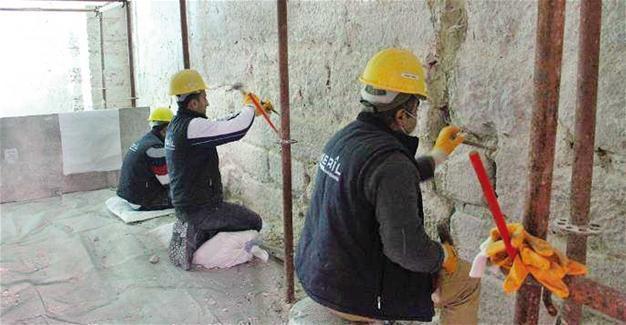High-tech backed repair begins at Topkapı Palace
Ömer Erbil
 After a number of scientific reports raised the alarm that Istanbul’s historic Topkapı Palace is sliding steadily toward the sea, officials have launched a restoration effort that is planned to take around three decades.
After a number of scientific reports raised the alarm that Istanbul’s historic Topkapı Palace is sliding steadily toward the sea, officials have launched a restoration effort that is planned to take around three decades. Cracks in the walls of the palace structure that have emerged in recent years are caused by this sliding, including in the Fatih Mansion, where the treasures of the palace are on display.
Big cracks on the walls and the domes of the Topkapı Palace were reported by daily Hürriyet on Sept. 26, 2016. Since the Fatih Mansion, which is home to priceless artifacts such as the Topkapı Emerald Dagger, the Spoonmaker’s Diamond, Nadir Shah Throne, emerald pitcher, golden helmet, prophet Osman’s golden sword and the ebony throne, is at risk of collapse, this part of the museum was closed to visitors for one year.
The cracks emerged when plaster was scraped during the restoration of the mansion. It was observed that the size of the deformations that appeared after the plaster was scraped reached the level of a fracture.
The presentation made by the Istanbul Directorate of Surveying and Monuments in the Heritage Istanbul Fair discussed the current situation of the palace and Culture and Tourism Minister Nabi Avcı mobilized all units of the ministry to address the issue.
The ministry has reportedly determined all scientific methods to rescue the palace and the Fatih Mansion was cleaned of its plasters. Movements in the land under the palace are thought to have caused the fractures in the walls, prompting experts to place electronic tools in almost all parts of the historical structure to monitor ground movements.
They will also measure the water pressure.
A 533-meter-long GPR (Ground Penetrating Radar) was placed through 26 drills and all ground movements will be recorded for the next 30 years.
For the determination of lateral movement on the ground, five inclinometer pipes were placed in drills to measure the underground water pressure.
In the sliding part, eight tilt meters were placed to understand the slide and amount of the movement. In addition, 24 crack detectors were placed on walls and the dome to monitor cracks in the structure.
All these tools are connected to the automatic data read and record system.
In order to prevent the palace from sliding toward the Marmara Sea, which it has been located above for centuries, a model for the ground has been planned.
A tota l of 578 piles will thus be driven underground and 129 soil nails will be placed horizontally under the structure, while a new 4.5-meter sustaining wall will also be built.
















